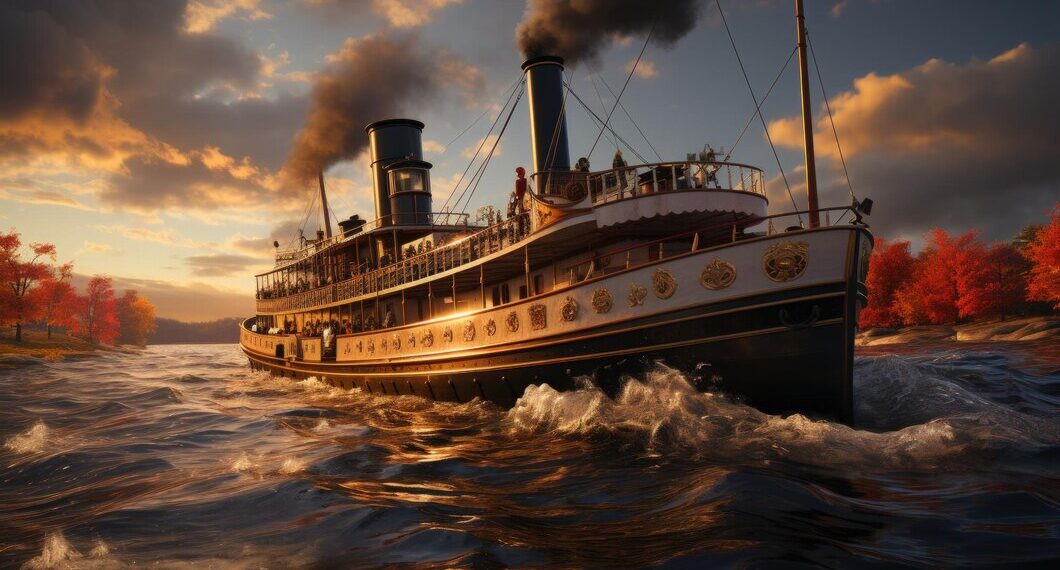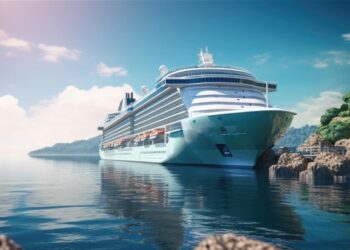From Maritime Majesty to Nautical Nobility: Tracing the Resplendent Evolution of Luxury Yachts
Luxury yachts embody the epitome of opulence, elegance, and extravagance on the high seas. These magnificent vessels have captured the imagination of adventurers, royal families, and wealthy individuals for centuries.
From their humble beginnings as pleasure barges for ancient civilizations to the awe-inspiring mega-yachts of today, luxury yachts have evolved alongside human innovation and societal aspirations. In this detailed exploration, we embark on a journey through time to trace their remarkable evolution over the centuries.
Definition of luxury yachts
A luxury yacht can be defined as a privately owned vessel that exceeds the standard requirements of functionality and comfort found in regular boats. It is an exclusive watercraft designed to provide an unparalleled leisure experience while cruising through picturesque seascapes or anchoring in glamorous harbours worldwide.
These exceptional vessels showcase extraordinary craftsmanship, cutting-edge technology, lavish amenities, and sophisticated interiors adorned with sumptuous materials that cater to every whim of its privileged occupants.
Importance of tracing their evolution over the centuries
Tracing the evolution of luxury yachts over the centuries serves as not only an exploration into nautical history but also a reflection of human progress and evolving aspirations. It allows us to understand how society’s perception of leisure and luxury has changed over time.
By studying these grand floating palaces, we gain insights into advancements in naval architecture, engineering feats, design trends, and shifts in social norms.
Furthermore, understanding their evolution helps us appreciate how technological innovations have made it possible for these vessels to become more extravagant than ever before.
A brief overview of the outline
This article will take you on a captivating voyage through time as we delve into different eras that have shaped luxury yachting history. We begin by exploring the early beginnings of luxury yachts in ancient civilizations such as Egypt and Rome, where extravagant vessels were an expression of power and wealth.
Then, we sail into the Renaissance period, known as the Golden Age of Sailing Yachts, to uncover how sailing technology advancements revolutionized yacht design. The Industrial Revolution ushered us into an era where steam-powered yachts emerged, becoming symbols of opulence during a time of rapid industrialization.
The twentieth century witnesses the transition from steam to internal combustion engines, leading to the birth of motor yachts and eventually mega-yachts. We arrive in the modern era with unprecedented levels of luxury adorning these floating palaces on water.

The Birth of Luxury Yachts
Ancient Civilizations and Their Extravagant Vessels
In the annals of maritime history, ancient civilizations left an indelible imprint on the concept of luxury yachts. The opulence and grandeur showcased by these early seafaring societies continue to captivate our imagination.
Among them, the Egyptian pharaohs reigned supreme with their magnificent boats that adorned the Nile waters. These vessels were not merely means of transportation but served as floating palaces, symbolizing the divine status of the rulers.
The most iconic example is undoubtedly Pharaoh Khufu’s Solar Barge, a royal yacht built for his journey through the afterlife. Crafted from imported cedarwood and adorned with precious metals, this vessel was a testament to craftsmanship and extravagance.
Egyptian Pharaohs and Their Opulent Boats
Egyptian pharaohs spared no expense when it came to their elaborate boats. One such remarkable example is Queen Hatshepsut’s ship, discovered in her mortuary temple at Deir el-Bahari in 1954.
This awe-inspiring vessel was over 70 feet long and showcased intricate carvings depicting scenes from Hatshepsut’s reign as one of ancient Egypt’s most powerful female rulers.
Its purpose remains shrouded in mystery, but its sheer size and ornate design serve as a testament to both technological prowess and opulence.
Roman Emperors and Their Pleasure Barges
The Romans too indulged in luxurious maritime escapades with lavish pleasure barges that graced their expansive empire’s waterways. Emperor Caligula was renowned for his extravagant lifestyle, epitomized by his floating palaces on Lake Nemi near Rome.
These colossal vessels boasted sprawling gardens, marble statues, luxurious staterooms, and even heated baths. One of the barges, known as “The Nemi Ships,” was discovered submerged in the lake during the early 20th century.
Their rediscovery unveiled a glimpse into the sheer grandeur and opulence that Roman emperors embraced aboard their pleasure craft.
Immersed in magnificence, these ancient civilizations set the stage for an enduring legacy of luxury yachts, laying the foundation for future generations to push boundaries and redefine opulence on water.
Renaissance Elegance: The Golden Age of Sailing Yachts
Development of sailing technology and its impact on luxury yachts
During the Renaissance period, sailing technology experienced significant advancements that revolutionized the world of luxury yachts. Shipbuilders and engineers explored new techniques to enhance both performance and aesthetics, leading to the creation of magnificent vessels that embodied elegance and grace.
These technological developments directly impacted the design and construction of luxury yachts, setting the stage for a golden age of sailing.
Advances in shipbuilding techniques and materials
Shipbuilders during the Renaissance era embraced innovative techniques to construct luxurious yachts that outshone their predecessors. Traditional wooden shipbuilding methods were refined, allowing for greater precision in crafting intricate hulls with enhanced strength and durability.
The use of seasoned timber, such as oak or teak, became prevalent due to their resistance to rotting and ability to withstand harsh maritime conditions. This introduced a new level of craftsmanship into yacht construction, ensuring longevity alongside opulence.
Introduction of multiple masts and larger sails
One notable development during this period was the introduction of multiple masts on sailing yachts, which significantly improved their manoeuvrability and capacity for sail area. Shipbuilders began constructing vessels with two or more masts, utilizing various rigging configurations like schooners or brigantines.
These additional masts allowed for better distribution of sail power, enabling faster speeds and overall superior performance on water. Moreover, larger sails capable of catching stronger winds were implemented, further enhancing both speed and stability while augmenting the grandeur associated with these majestic vessels.
The Renaissance era witnessed a remarkable fusion between artistic expression and technological progress in luxury yacht design. As shipbuilders continuously refined their skills while collaborating with skilled artisans, these sailing masterpieces became truly awe-inspiring works of art that navigated the seas with both grace and power.

The Industrial Revolution: From Steam Power to Opulence
Emergence of Steam-Powered Luxury Yachts
During the Industrial Revolution, a momentous shift occurred in the world of luxury yachts as steam power began to replace traditional sailing methods. This transition allowed for unprecedented speed and comfort on the water, revolutionizing the concept of opulence and grandeur.
Pioneering visionary shipbuilders played a crucial role in this transformation, crafting magnificent vessels that would set new standards for luxury yachts.
John Scott Russell’s “The Fairy Queen”
One notable figure in this era was John Scott Russell, whose illustrious creation “The Fairy Queen” captivated imaginations with its exceptional splendour. Launched in 1831, this steam-powered yacht was an extraordinary feat of engineering excellence.
With its sleek design and state-of-the-art propulsion system, it showcased Russell’s unrivalled mastery of blending form and function. The Fairy Queen became a symbol of prestige among the elite, heralding a new era of luxurious sea travel.
Robert Napier’s “Lalla Rookh”
Another influential figure during this transformative period was Robert Napier, a visionary engineer who brought forth his masterpiece: “Lalla Rookh.” This majestic steam yacht entered service in 1845 and swiftly garnered acclaim for its opulent interiors and technological prowess.
Napier meticulously crafted every detail of Lalla Rookh to exude extravagance, from the lavish furnishings to the ornate decorations adorning its spacious decks. It became an iconic symbol of refined elegance that set the bar high for future steam-powered luxury yachts.
The Rise of Opulence in Steam-Powered Yachts
With steam power came unparalleled opportunities for indulgence aboard luxury yachts. As technology advanced rapidly, so did the level of opulence offered to the fortunate few who could afford these magnificent vessels.
Steam-powered yachts became floating palaces, indulging their affluent owners and guests with an array of luxurious interiors and amenities.
Luxurious Interiors and Amenities
The interiors of these steam-powered giants were opulent beyond imagination. Elaborate saloons adorned with intricate woodwork, sumptuous upholstery, and exquisite artwork created an ambience of sheer indulgence.
These lavish spaces often boasted extravagant chandeliers, gilded mirrors, and ornate fireplaces that mirrored the grandeur of palatial residences. With increasing competition among yacht builders to outdo one another in terms of luxury, no expense was spared in ensuring the most refined experience for those on board.
Every aspect of comfort was meticulously attended to aboard these steam-powered yachts. Lavishly furnished cabins provided respite for weary passengers, while grand dining rooms catered to their culinary desires with lavish banquets prepared by skilled chefs.
Spa facilities offer relaxation and rejuvenation with state-of-the-art bathing facilities and treatments.
The incorporation of innovative amenities such as libraries stocked with precious literary works, gaming rooms equipped with billiard tables, and even indoor greenhouses added an extra touch of extravagance.
Social Status Symbol for the Elite
Steam-powered luxury yachts swiftly transcended their practical purpose as they became a symbolic representation of social status among the elite class during the Industrial Revolution. Owning or travelling on such a vessel signified immense wealth, sophistication, and exclusivity.
The extravagant parties held on board these floating marvels became legendary social events attended by influential figures from various spheres – aristocrats, business magnates, artists, and even royalty.
These majestic yachts transformed into floating stages where the elite would parade their opulence before one another in pursuit of recognition and admiration.
Their journeys along picturesque coastlines or across serene lakes served as showcases of their affluence, intertwining the allure of luxury travel with the desire to impress peers. Steam-powered yachts became status symbols, elevating the notion of wealth and power to new heights on both land and water.
In this remarkable era, steam-powered luxury yachts emerged as magnificent embodiments of human ingenuity, opulence, and social stratification.
As we delve deeper into the modern era, we will witness how these marvels continued to evolve and adapt to changing times, forever leaving an indelible mark on the history of maritime extravagance.
Twentieth Century Innovations: From Motor Yachts to Mega Yachts
Transition from Steam to Internal Combustion Engines
The twentieth century witnessed a remarkable shift in luxury yacht propulsion, as the era of steam-powered vessels gradually gave way to the efficiency and versatility of internal combustion engines.
This transition marked a significant turning point in the development of luxury yachts, offering owners newfound freedom and flexibility on the open seas.
The adoption of internal combustion engines allowed for greater manoeuvrability, reduced reliance on coal or wood fuel, and ultimately propelled yachting into a new era of innovation. With this transformation came a wave of advancements that revolutionized both the performance and functionality of luxury yachts.
Introduction of Motorized Luxury Yachts by Charles Henry Fletcher
One name that stands out amidst this transformative period is that of Charles Henry Fletcher, an influential figure who played an instrumental role in introducing motorized luxury yachts to the world.
Fletcher’s visionary approach combined with his engineering prowess led him to create groundbreaking vessels that captured the imagination of yacht enthusiasts globally.
His iconic creation, “The Arrow,” unveiled in 1908, showcased not only his technical expertise but also his keen eye for luxurious design and unmatched attention to detail.
The sheer elegance and speed displayed by “The Arrow” captivated yacht connoisseurs worldwide, firmly establishing motorized luxury yachts as the epitome of opulence and style.
Technological Advancements in Engine Power, Speed, and Reliability
As motorization took centre stage in the luxury yacht industry during the twentieth century, technological advancements surged forward at an unprecedented pace.
Engineers continuously pushed boundaries to improve engine power output while simultaneously enhancing speed and reliability. Improved fuel injection systems allow for better combustion control, resulting in increased efficiency and reduced emissions.
Innovations like supercharging and turbocharging further boosted engine performance, enabling luxury yachts to reach previously unimaginable speeds.
Moreover, breakthroughs in marine engineering led to the development of robust and reliable engine designs, minimizing maintenance requirements and ensuring uninterrupted enjoyment for yacht owners and their discerning guests.
These technological advances not only revolutionized the capabilities of luxury yachts but also set new standards for comfort, performance, and reliability in the world of maritime leisure.
Overall, the transition from steam to internal combustion engines marked a pivotal moment in the evolution of luxury yachts.
Through figures like Charles Henry Fletcher and a wave of technological advancements, motorized luxury yachts emerged as vessels that combined style with substance. This era laid the foundation for subsequent developments that would propel luxury yacht design into uncharted waters.
The Modern Era: Unprecedented Luxury on Water
The Advent of Mega-Yachts
In the modern era, luxury yachts have reached unparalleled levels of opulence and grandeur. The introduction of mega-yachts has revolutionized the concept of luxury on water. These floating palaces are a testament to human ingenuity and craftsmanship, redefining the boundaries of extravagance.
Mega-yachts push the limits with their sheer size, glamorous amenities, and lavish designs. They are a symbol of wealth and status that allows their owners to indulge in the utmost luxury while cruising through picturesque waters.
Exploring the World’s Largest Mega-Yacht – “Azzam”
Amongst these extraordinary vessels, one stands out as an emblematic representation of luxury and engineering prowess – “Azzam,” currently holding the title of being the world’s largest mega-yacht.
Owned by Sheikh Khalifa bin Zayed Al Nahyan, President of the United Arab Emirates and Emir of Abu Dhabi, “Azzam” is an exceptional masterpiece in every sense. With its impressive specifications, this mammoth yacht stretches over 590 feet in length (equivalent to two football fields), making it longer than most cruise ships.
Its sleek exterior design exudes elegance and power, crafted by renowned Italian shipyard Lürssen Yachts in collaboration with esteemed designer Nauta Yachts. The interior is a quintessence of taste and sophistication.
Curated by French designer Christophe Leoni, it boasts decadent spaces tailored for entertainment and relaxation. Intricately designed cabins accommodate up to 36 guests who can revel in luxurious comfort during their voyage.
Conclusion
As we trace the evolution from steam-powered vessels to today’s mega-yachts like “Azzam,” it becomes evident that luxury yachting has become an art form. These floating marvels combine cutting-edge technology, architectural brilliance, and unparalleled luxury.
They offer a sanctuary for the affluent where they can escape the demands of everyday life and embrace a world of indulgence.
The evolution of luxury yachts symbolizes our innate desire for exploration, refinement, and the pursuit of ultimate pleasure. In this age of ever-advancing luxury yachts, we are reminded that human creativity knows no bounds when it comes to crafting extraordinary experiences on the water.













